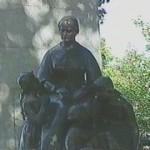In Canada in 1665, June had turned into July, bringing maturing crops and an abundance of wild berries. In the fields, men worked with oxen, pulling up stumps, harrowing new land. Their wives guarded them with muskets at the ready. The days were hot and long. In Québec, people adjusted to the influx from France—mostly young men. Mothers and fathers kept a close eye on their daughters. More ships were expected.
On July 16, the Marie-Thérèse, having left Le Havre on May 10, sailed into port. It was captained be the Sieur Poullet (Puet[1]) a frequent visitor to the colony who, in addition to bringing supplies, had two welcome cargoes—twelve horses[2] sent by the new Intendant, Jean Talon, who was yet to arrive and eight filles du roi.
Aboard the Marie-Thérèse, among the eight filles du roi who were coming to find husbands was a normande, Marthe Quittel, a Protestant from Rouen. Jean Bourdon was from Rouen and so it was understandable that his wife Madame Bourdon would have recruited girls there. It may have been she who was responsible for bringing the rouennaise Marthe Quittel. As chaperone, Madame Bourdon had likely taken it upon herself to instruct Marthe in the tenets of Catholicism. Although Marthe had been baptized a Catholic at the church of St. Maclou in Rouen in 1638, she had converted to Calvinism. Because Protestants could not stay openly in New France, this impoverished fille du roi, on the day after her arrival in New France, knowing that a return to Rouen held no promise for her, “abjured” Calvinism and “accepted the one, true faith” before Father Ango des Maizerets, the representative of Bishop François de Montmagny Laval [1].
In the next excerpt of Here to Stay, a book-length account of my 17 century ancestors, we read how Marthe met her future husband.
This post is one of over 500 informative, well-written articles we have made available to you on this site.
We’ve contributed to your writing success; now we ask you to contribute to the expansion of the memoir conversation.
By reposting this article on your blog or website or reposting on your favorite social media, you will inform your fellow memoir writers of the programs and services—many for free like the blogs—that are available at TheMemoirNetwork.com.
Thanks for your generosity. You rock.


No comments yet.